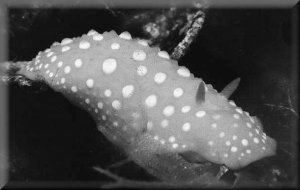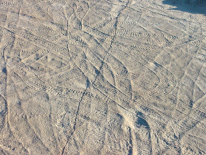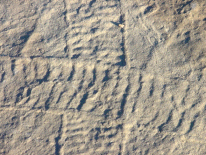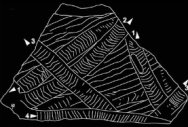 As
you enter the past-life section of the National Museum of Natural
History (Smithsonian) one is struck by the fossil
cast some eight-foot tall of the mysterious Cambrian fossil
Climactichnites. They resemble tracks made by a motorcycle
both is size and character. Described by Sir William Logan
in 1860, Climactichnites was believed at that time
to come from the oldest sedimentary formation known; the Canadian
formation is now known to be Upper Cambrian. The fossil caused
considerable controversy among paleontologists, and speculation
regarding the track maker's identity abounded. Arthropods with
soft bodies were denied by the lack of footprints. The possibility
of a snail was denied by the V-shaped ridges, and that no known
Cambrian snail or worm (even today) can account for the tracks
that can be
As
you enter the past-life section of the National Museum of Natural
History (Smithsonian) one is struck by the fossil
cast some eight-foot tall of the mysterious Cambrian fossil
Climactichnites. They resemble tracks made by a motorcycle
both is size and character. Described by Sir William Logan
in 1860, Climactichnites was believed at that time
to come from the oldest sedimentary formation known; the Canadian
formation is now known to be Upper Cambrian. The fossil caused
considerable controversy among paleontologists, and speculation
regarding the track maker's identity abounded. Arthropods with
soft bodies were denied by the lack of footprints. The possibility
of a snail was denied by the V-shaped ridges, and that no known
Cambrian snail or worm (even today) can account for the tracks
that can be six or more inches wide.
six or more inches wide.
Yochelson
and Fedonkin hypothsized on the nature of Climactichnites.
They posit an animal twice as long as wide having a strongly
muscled underside with oblique rows of cilia and lateral flaps.
The cilia may have been used to sort through sand for microorganisms
and its lateral wings to grip for locomotion. In the process
of feeding, sand was shoved into the conspicuous periodic rows.
The flaps may also have been used for swimming. Since Climactichnites
is found on bedding surfaces with ripple marks and mud cracks,
it probably spent most of its life moving across the tidal
sand
flats that were at least periodically above the water. Thus,
Climactinites remains a mystery from the Phylum that perhaps
came and went during the Cambrian, or also, the ancestor of
other animals that went on to migrate more completely to the
land.
 More
recently, Damrow
et. al. have suggested that an alternative explanation for
More
recently, Damrow
et. al. have suggested that an alternative explanation for Climactichnites is as a body fossil. Based on new fossils from
a sandstone quarry in central Wisconsin they propose that the
evidence shown on numerous sandstone slabs is equally compatible
with the hypothesis that Climactichnites fossils are body impressions
of a gelatinous zooplankter (Zooplankton) that floated into
shallow water where they were deposited gently across the extensive
tidal sand flats. The picture below links to more pictures of
what is surely the most impressive, Climacticnites ever found
in the Wisconsin quarry.
Climactichnites is as a body fossil. Based on new fossils from
a sandstone quarry in central Wisconsin they propose that the
evidence shown on numerous sandstone slabs is equally compatible
with the hypothesis that Climactichnites fossils are body impressions
of a gelatinous zooplankter (Zooplankton) that floated into
shallow water where they were deposited gently across the extensive
tidal sand flats. The picture below links to more pictures of
what is surely the most impressive, Climacticnites ever found
in the Wisconsin quarry.
 The
most extensive research on Climactichnites was more recently
conducted by Getty and Hagadorn, to include rigorous sedimentology
analysis at the Blackberry Hill site in Wisconsin (Elk Mound
Group). They conclude the most likely maker was a Cambrian
soft-bodied, mollusc-like animal reaching more than two feet
in length, making it one the largest Cambrian animals of
the time. Locomotion was by a muscular foot, much like a
modern gastropod. A host of sedimentary evidence (especially
raindrop impressions) demonstrate that the Climactichnites
maker inhabited subaerially exposed environments. Abundant
microbial sedimentary structures associated with Climactichnites
suggest microbial mat binding, togeth with postulated low
levels of vertical bioturbation would explain trackway preservation.
Footprints of Climactichnites together with Protichnites
may be the first animal footprints on land..
The
most extensive research on Climactichnites was more recently
conducted by Getty and Hagadorn, to include rigorous sedimentology
analysis at the Blackberry Hill site in Wisconsin (Elk Mound
Group). They conclude the most likely maker was a Cambrian
soft-bodied, mollusc-like animal reaching more than two feet
in length, making it one the largest Cambrian animals of
the time. Locomotion was by a muscular foot, much like a
modern gastropod. A host of sedimentary evidence (especially
raindrop impressions) demonstrate that the Climactichnites
maker inhabited subaerially exposed environments. Abundant
microbial sedimentary structures associated with Climactichnites
suggest microbial mat binding, togeth with postulated low
levels of vertical bioturbation would explain trackway preservation.
Footprints of Climactichnites together with Protichnites
may be the first animal footprints on land..
References




